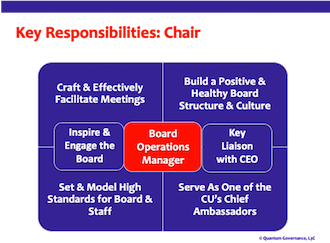4 minutes
In addition to playing an important role in managing the CEO, the chairman also plays a key role in managing the board itself.
When we work with credit union boards, and in particular with chairs, we’ll often start by asking the provocative question, “Should boards manage?” Immediately the resounding response, of course, is “No!” But when we ask our clients to dig a little deeper, to think a little harder about the important work they do to govern their credit unions, ultimately one brave individual will, in a quiet, tentative voice say, “Yes … ?” That response is often more of a question than an answer—remembering that the board is responsible for managing its one employee, the credit union’s CEO.
Go further, we implore them. Deeper.
The board is also responsible for managing itself—for managing the work of the board, or ensuring that it effectively and efficiently fulfills its solemn roles and responsibilities. And to that end, we consider the chair to be the “Board Operations Manager in Chief.”
But how many chairs are fully prepared to take up this important mantle? If you are, or have been, the chair of your credit union’s board, did you go to school to learn how to be effective? Did you attend board meeting facilitation training? Get schooled in board meeting agenda design? Public speaking? CEO relations? You get the point.
It’s been our experience that many board chairs ascend to the position feeling not quite prepared to take on all of these responsibilities. In fact, many of them don’t fully understand the full breadth of the chair’s responsibilities.
Consider the following job description. Today’s contemporary board chair is responsible for:
 Crafting & Effectively Facilitating Meetings
Crafting & Effectively Facilitating Meetings
- Set the agenda for board and executive committee meetings in concert with the CEO.
- Call to order and preside over meetings of the board and the executive committee.
- Encourage and expect full and robust participation of board members at meetings.
- Help to maintain a healthy balance between operational and strategic discussions.
Building a Positive & Healthy Board Structure & Culture
- Appoint committee and task force chairs as well as committee members. This “appointment power” is perhaps one of the most important responsibilities most chairs have!
- Work with the governance and nominations committee (if you have one—If you don’t have one, charter one now!) to ensure appropriate and effective identification, recruitment and onboarding of new board members.
- Work with the governance and nominations committee to create a positive and effective board and board member process.
- Serve on the executive committee and as an ex-officio member of all board committees.
Acting as Key Liaison With the CEO
- Act as a representative of the board as a whole, rather than as an individual supervisor to the CEO.
- Help to establish the strategic direction of the credit union, working in partnership with board colleagues and the CEO.
- Work with the treasurer, the directors and the CEO to oversee the credit union’s budget and support the development of and adherence to sound fiscal policies to safeguard the integrity of the credit union’s financial management systems.
- Optional: Have the power to sign, in addition to the CEO, on behalf of the credit union, all contracts authorized either generally or specifically by the Board.
Setting & Modeling High Standards for Board & Staff
- Oversee efforts to build and maintain an exceptional governing board by setting goals and expectations for its members.
- Convening board discussions on evaluating the CEO and ensuring the effective negotiation of the CEO’s compensation and benefits package, as well as serve as a key conduit for information to the CEO.
Acting as One of the Credit Union’s Chief Ambassadors
- Serve as the official spokesperson for the board among community members and the media, in addition to the CEO.
- Encourage board members to act as credit union ambassadors and encourage board member participation in credit union events, as appropriate.
Inspire & Engage the Board
- Inspire a shared commitment to the credit union’s vision, mission and strategic goals.
- Cultivate leadership among board members.
- Encourage board member development, including further education in the credit union’s governance.
The good news is this: There is training for future or existing board chairs. In fact, we’re leading one for CUES. This will be a time and place where you can deepen your understanding about your fundamental roles and responsibilities and gain critical knowledge about building an effective board culture, evaluating your CEO and even facilitating great board meetings. We promise an engaging, provocative exchange that will push you to the edge of best practice in board leadership.
Michael Daigneault, CCD, is CEO/founder of Quantum Governance L3C, Herndon, Virginia, CUES’ strategic provider for governance services. Daigneault has more than 30 years of experience in the field of governance, management, strategy, planning and facilitation, and served as an executive in residence at CUES Governance Leadership Institute™.
Jennie Boden serves as the firm’s managing director of strategic relationships and a senior consultant. She has more than 25 years of experience in the national nonprofit sector and served as the chief staff officer for two nonprofits before coming to Quantum Governance.







